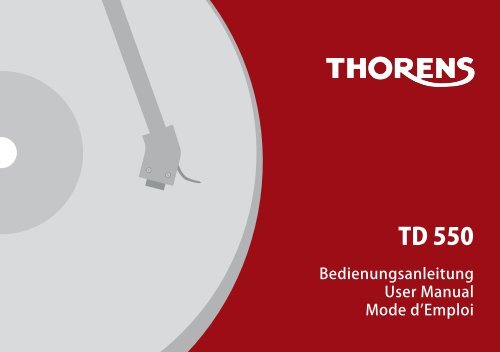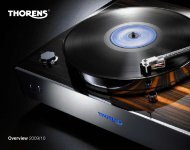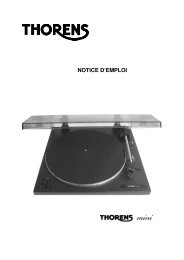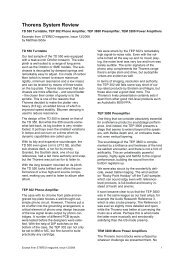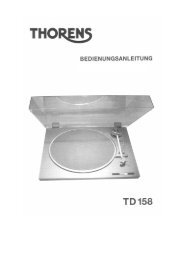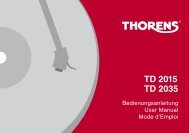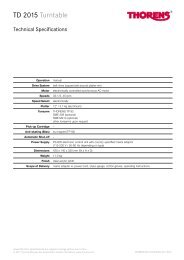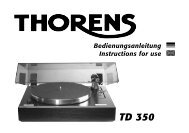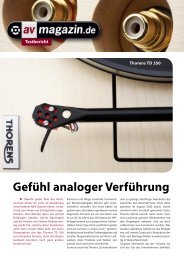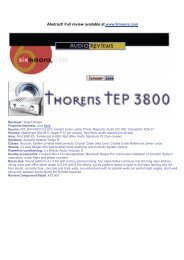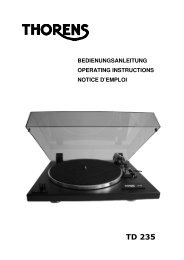You also want an ePaper? Increase the reach of your titles
YUMPU automatically turns print PDFs into web optimized ePapers that Google loves.
Entfernen Sie nun die ab Werk eingedrehten Transportsicherungsschrauben,<br />
so dass das Subchassis frei schwingen<br />
kann. Bewahren Sie diese unbedingt auf. WICHTIG:<br />
Bitte transportieren Sie Ihren <strong>TD</strong> <strong>550</strong> immer nur mit eingedrehten<br />
Transportsicherungsschrauben.<br />
Setzen Sie nun den Plattenteller vorsichtig in das Lager<br />
ein. Wenden Sie hierzu keinesfalls Gewalt an, sondern<br />
lassen Sie den Teller langsam ins Lager gleiten. Durch die<br />
gehärtete Achse könnte sonst die Lagerbuchse zerstört<br />
werden.<br />
Wenn der Teller sitzt, drehen Sie ihn an und prüfen Sie die<br />
Leichtgängigkeit des Lagers. Nehmen Sie jetzt den Riemen<br />
aus der Verpackung und legen Sie ihn um den Teller<br />
und die links hinten platzierte Motor-Riemenscheibe. Achten<br />
Sie auf den korrekten Sitz des Riemens.<br />
10<br />
Vermeiden Sie Öl- oder Fettspuren auf Antriebsriemen,<br />
Motor-Riemenscheibe und der Außenfläche des Plattentellers.<br />
Falls notwendig, können Sie diese Teile mit<br />
einem in reinem Alkohol getränkten, nicht fasernden<br />
Tuch oder Lappen reinigen.<br />
Legen Sie die Filzmatte auf den Teller. Die Filzmatte ist<br />
weich, aber rutschhemmend und bewahrt Ihre Schallplatten<br />
vor Abnutzung während des Abspielvorgangs. Sollte<br />
die Matte aufgrund statischer Aufladung an der Platte haften<br />
bleiben, so entfernen Sie bitte die Ladungen vor dem<br />
Abspielen mit einer geerdeten Karbonfaserbürste oder<br />
waschen Sie die Platten regelmäßig.<br />
Nehmen Sie jetzt die drei Subchassiseinstellschrauben<br />
aus der Verpackung und setzen Sie diese in die vorgesehenen<br />
Öffnungen ein (Abb. 2). Aus klanglichen Gründen<br />
können die Schrauben nicht fest fixiert sein.<br />
Prüfen Sie nun mit der beiliegenden Libelle, ob auch das<br />
Subchassis waagrecht steht. Falls erforderlich können<br />
Sie dieses mittels der drei Subchassiseinstellschrauben<br />
in die Waagrechte bringen. Bei Verwendung eines sehr<br />
schweren Plattenbeschwerers sollten Sie diesen ebenfalls<br />
jetzt auflegen und mit den drei Einstellschrauben das<br />
Absinken des Subchassis wieder ausgleichen. Das Subchassis<br />
muss nun frei schwingen können und sollte exakt<br />
bündig zu der Zargenoberfläche sein.
Verbinden Sie den Erdungsanschluss des <strong>TD</strong> <strong>550</strong> (8) mithilfe<br />
des beiliegenden Erdungskabels mit dem Erdungsanschluss<br />
Ihres Verstärkers oder eines beliebigen Eingangs.<br />
Achten Sie bei der Aufstellung Ihres neuen Plattenspielers<br />
darauf, einen Mindestabstand zu anderen elektronischen<br />
Geräten (z.B. Verstärker, Receiver oder CD-Spieler) einzuhalten,<br />
da es sonst zu magnetischen Einstrahlungen auf<br />
das Tonabnehmersystem kommen kann, welche sich<br />
durch Brummstörungen in der Wiedergabe äußern.<br />
12<br />
Magnetische Störungen kann man leicht ermitteln und<br />
beseitigen, indem man Aufstellung und Position der<br />
Geräte zueinander verändert.<br />
<strong>Thorens</strong> Plattenspieler sind relativ unempfindlich gegenüber<br />
Erschütterungen. Dennoch stellen diese ein generelles<br />
Problem bei der Plattenwiedergabe mit hochwertigen Tonabnehmern<br />
dar. Wählen Sie deshalb ein möglichst stabiles<br />
Möbelstück zur Aufstellung und vermeiden Sie die Nähe<br />
zu Lautsprechern.<br />
Leider reicht dies in älteren Häusern mit Holzbalkendecken<br />
bisweilen nicht aus. In der Regel hilft hier allerdings<br />
die Aufstellung des Plattenspielers auf einer Konsole, die<br />
mit geeigneten Konsolenträgern an einer tragenden Zimmerwand<br />
befestigt wird.
Gehen Sie wie folgt vor, um eine Schallplatte abzuspielen:<br />
Öffnen Sie die Haube, nehmen Sie die Schallplatte aus der<br />
Hülle, und legen Sie sie auf den Plattenteller. Spielen Sie<br />
Ihre Platten nie ohne die schützende Filzmatte ab. Für Singles<br />
haben wir einen Single-Adapter beigelegt. Vor jedem<br />
Abspielvorgang empfehlen wir, den Oberflächenstaub auf<br />
der Platte mit Hilfe einer Kohlefaserbürste oder einem Antistatiktuch<br />
zu entfernen. Alte, stark verstaubte Platten<br />
können durch eine Intensivreinigung mit einer Schallplattenwaschmaschine<br />
wieder stark aufpoliert werden.<br />
Schalten Sie den Motor ein und wählen Sie die passende<br />
Geschwindigkeit. Entriegeln Sie den Tonarm, und schwenken<br />
Sie ihn nach innen über die gewünschte Rille. Durch<br />
Betätigen des Tonarmlifthebels können Sie den Tonarm<br />
nun langsam absenken.<br />
Beim Abspielbetrieb können Sie die Haube abgesenkt lassen.<br />
Jedoch können hierdurch Klangverfälschungen auftreten,<br />
da der von den Lautsprecherboxen abgestrahlte<br />
Schall die Luftsäule unter der Haube anregt.<br />
WICHTIG: Achten Sie beim Anheben des Tonarms mit<br />
dem Lift darauf, dass Sie den Lifthebel langsam betätigen,<br />
damit der Tonarm nicht springt.<br />
Der Plattenspieler besitzt keine automatische Endabschaltung.<br />
Sobald die Auslaufrille erreicht ist, muss der Tonarm<br />
mittels Handlift von der Platte gehoben und der Motor abgeschaltet<br />
werden.<br />
19
Continue by detaching the locking screws which have<br />
been factory-installed for safe transportation. Make sure<br />
the suspended chassis is freely oscillating after having removed<br />
the screws. IMPORTANT: it is highly recommended<br />
to save the locking screws and re-install them in case the<br />
record player needs to be transported again.<br />
Now take the platter with both hands and hold its axle<br />
perpendicular over the hole in the bearing. Slowly and very<br />
carefully insert the axle into the bearing while making sure<br />
that it must not forcefully hit the bottom plate of the bearing.<br />
After the platter has been put in place turn it manually to<br />
see if it runs smoothly and with ease. Take the belt from<br />
the packaging and carefully loop it around the outer rim<br />
of platter and motor pulley. Please check if the belt sits<br />
straight on platter and pulley and is not twisted.<br />
Avoid any oil or greasy substance to get onto belt and<br />
the transmission area of platter and motor pulley. If<br />
necessary you may clean them with a lint-free tissue<br />
soaked in an alcoholic dilution (e.g. ethanol).<br />
Put felt mat on platter. It is soft and will protect your<br />
records from damages that may occur during playback.<br />
If the felt mat is to stick against the record owing to static<br />
charges, you may discharge the record before playback<br />
by running a carbon fibre brush across. For best result<br />
this brush should be connected to ground by a lead. Frequently<br />
cleaning the records with a dedicated cleaning<br />
machine can also remedy static charges.<br />
Take the three screws for adjusting the suspended chassis<br />
from the packaging and insert them into the prepared<br />
openings (Fig. 2) on top of the plinth. For sonic reason<br />
these screws cannot be firmly fixed.<br />
With the help of the supplied spirit level you can now check<br />
if the suspended chassis also is in a perfectly horizontal<br />
level. If necessary, you can re-adjust by the three screws.<br />
Please take into consideration to adapt adjustments if a<br />
particularly heavy record weight is to be employed. After<br />
having achieved a perfect level the suspended chassis<br />
should be freely oscillating and should be precisely flush<br />
with respect to the plinth‘s top plate.<br />
29
Take the supplied ground lead and connect the ground<br />
post (8) at the rear panel with the ground post on your<br />
preamplifier/amplifier or separate phono-preamplifier.<br />
When placing your record player onto its final position<br />
make sure it is a fair distance away from other audio devices<br />
(e.g. amplifiers, receives or CD players). This measure<br />
is to avoid electro-magnetic interferences which can yield<br />
a distorting effect in the sensitive pickup cartridge which<br />
may be audible as hum during playback.<br />
Electro-magnetic interferences however can be disclosed<br />
and eliminated by simply changing the position<br />
of the record player with respect to the other audio<br />
components.<br />
<strong>Thorens</strong> record players are relatively insensitive when subject<br />
to foot-fall shocks or airborne vibrations. Nevertheless,<br />
a general problem remains when it comes to playing<br />
back vinyl records with a high-quality pickup cartridge. It is<br />
therefore highly recommended to go for a sturdy piece of<br />
furniture or rack for placement, whereby a close proximity<br />
of the record player to the loudspeakers is to be avoided.<br />
Under certain circumstances all these precautions may not<br />
be good enough in older houses with wooden floor construction.<br />
Here, in most cases a solid shelf firmly mounted<br />
to a supporting wall can be very beneficial to the sonic<br />
properties of the record player if it is placed on such a shelf<br />
or console.<br />
31
For playing your records proceed as follows:<br />
Open dustcover, take the record from its cover and inner<br />
sleeve and put it on platter. Never play your records<br />
without the protective felt mat! A special adaptor has<br />
been supplied for single records with large centre hole.<br />
It is highly recommended to always remove surface dust<br />
with the help of a special carbon brush or anti-static tissue<br />
before each playback. Older or very dusty records can be<br />
thoroughly cleaned with a dedicated record washing machine.<br />
This procedure will also improve sound quality.<br />
Switch motor on and the select speed according to the<br />
record to be played. Unlock tonearm from its rest and<br />
move it over the desired piece to be played. By lowering<br />
the tonearm lift lever the tonearm is slowly descending.<br />
38<br />
You may have the dustcover closed during playback but<br />
sound waves from the speakers can excite the air beneath<br />
the cover and thus induce sonic distortions.<br />
IMPORTANT: if you want to lift the tonearm up by the lever,<br />
do it smoothly in order to avoid that the tonearm is bouncing<br />
about the record.<br />
This record player does not feature any automatic shut-off<br />
facility at the end of the record. Therefore, as soon as the<br />
stylus has reached the lead-out groove, the tonearm is to<br />
be lifted up manually by the lever and the motor switched<br />
off.
Enlevez maintenant les vis de sécurité pour le transport<br />
vissées en usine, pour libérer le châssis. Conservez-les<br />
précieusement. IMPORTANT : ne transportez votre <strong>TD</strong><br />
<strong>550</strong> qu’avec les vis de sécurité de transport en place et<br />
serrées.<br />
Placez maintenant prudemment le plateau sur son palier.<br />
Ne jamais forcer, laissez lentement glisser le plateau dans<br />
son palier. Sinon, l’axe en acier trempé pourrait endommager<br />
la douille du palier.<br />
Quand le plateau est en place, faites-le tourner et vérifiez<br />
la souplesse du palier. Sortez maintenant la courroie de<br />
l’emballage, placez-la autour du plateau et sur la poulie du<br />
moteur située au fond à droite. Veillez à la bonne assise<br />
de la courroie.<br />
48<br />
Evitez toute trace d’huile ou de graisse sur la courroie<br />
d’entraînement, poulie du moteur et la surface externe<br />
du plateau. Si nécessaire, vous pouvez nettoyer ces<br />
pièces à l’aide d’un chiffon doux non pelucheux imprégné<br />
d’alcool pur.<br />
Posez le tapis de feutre sur le plateau. Le tapis est moelleux,<br />
mais antiglisse ment et protège vos disques de l’usure<br />
pendant le processus de lecture. Si le tapis restait collé<br />
au disque en raison de la charge électrostatique, éliminer<br />
celle-ci avant la lecture à l’aide d’une brosse en fibres de<br />
carbone reliée à la terre ou lavez régulièrement les disques.<br />
Sortez maintenant les trois vis de réglage du sub-châssis<br />
de l’emballage et introduisez-les dans les orifices prévus à<br />
cet effet (fig. 2). Pour des raisons de qualité de son les vis<br />
ne peuvent pas être serrées.<br />
Vérifiez maintenant également l’horizontalité du sub-châssis<br />
à l’aide du niveau à bulle joint. Si nécessaire, corrigez<br />
l’horizontalité à l’aide des trois vis de réglage du sub-châssis.<br />
En cas d’utilisation d’un lestage important du plateau,<br />
effectuez le réglage à l’aide des trois vis de réglage en<br />
présence du lestage, pour compenser l’abaissement du<br />
sub-châssis. Le sub-châssis doit maintenant être en mesure<br />
d’osciller librement et exactement affleurer la surface<br />
supérieure du châssis.
Reliez la prise de terre <strong>TD</strong> <strong>550</strong> (8) avec l’aide du câble<br />
de terre joint, à la prise de terre de votre amplificateur ou<br />
l’entrée de votre choix.<br />
Lors de l’installation de votre nouvelle platine, veillez à<br />
respecter une distance minimale par rapport aux autres<br />
appareils électroniques (par ex. amplificateurs, récepteurs<br />
ou lecteur de CD), car cela pourrait provoquer des rayonnements<br />
électromagnétiques sur le système de lecture de<br />
son, avec des bourdonnements dans la restitution.<br />
50<br />
Les perturbations magnétiques peuvent être facilement<br />
identifiées et éliminées, en modifiant la position<br />
de la platine par rapport aux autres appareils.<br />
Les platines <strong>Thorens</strong> sont relativement insensibles aux vibrations.<br />
Cependant, celles-ci posent en général un problème<br />
pour la reproduction de disques avec des cellules<br />
de lecture de qualité supérieure. Choisissez un meuble<br />
stable comme support et évitez la proximité des hautparleurs.<br />
Mais ceci n’est pas suffisant dans le cas d’anciennes demeures<br />
avec poutraison de plancher en bois. En général,<br />
dans ce cas, il est utile de placer la platine sur une console<br />
qui est elle-même vissée au mur porteur de la pièce, à<br />
l’aide de ses propres supports de console.
Procédez comme suit pour écouter un disque :<br />
Ouvrez le capot, sortez le disque de sa pochette et déposez-le<br />
sur le plateau. Utilisez toujours le tapis de protection<br />
en feutre. Pour l’écoute des singles nous avons joint un<br />
adaptateur. Avant chaque lecture du disque, nous recommandons<br />
d’éliminer la poussière de surface à l’aide d’une<br />
brosse à fibres de carbone ou un chiffon antistatique. De<br />
vieux disques très empoussiérés peuvent être bien repolis<br />
par un nettoyage intensif à l’aide d’une machine à laver<br />
les disques.<br />
Mettez le moteur en marche et sélectionnez la vitesse<br />
adaptée. Déverrouillez le bras de lecture et déplacez-le<br />
au dessus du sillon souhaité. En actionnant le levier du<br />
lève-bras vous pouvez descendre lentement le bras de<br />
lecture.<br />
Vous pouvez laissez le capot fermé pendant la lecture du<br />
disque. Cependant, ceci peut provoquer des distorsions<br />
du son, car les ondes sonores générées par les enceintes<br />
peuvent exciter la colonne d’air située sous le capot.<br />
IMPORTANT : veillez à soulevez lentement le bras de lecture<br />
à l’aide du levier, afin d’éviter que le bras ne saute.<br />
La platine n’est pas équipée d’un arrêt automatique de fin<br />
de disque. Dès que le sillon de fin de disque est atteint, le<br />
bras de lecture doit être levé au dessus du disque à l’aide<br />
du lève-bras et le moteur doit être arrêté.<br />
57
© 2007 <strong>Thorens</strong> Export Company AG<br />
Im Huebel 1, CH-4304 Giebenach<br />
E-Mail: info@thorens.com<br />
Internet: www.thorens.com
analog high fidelity<br />
Printed in Germany · UM<strong>550</strong>-1107-A


